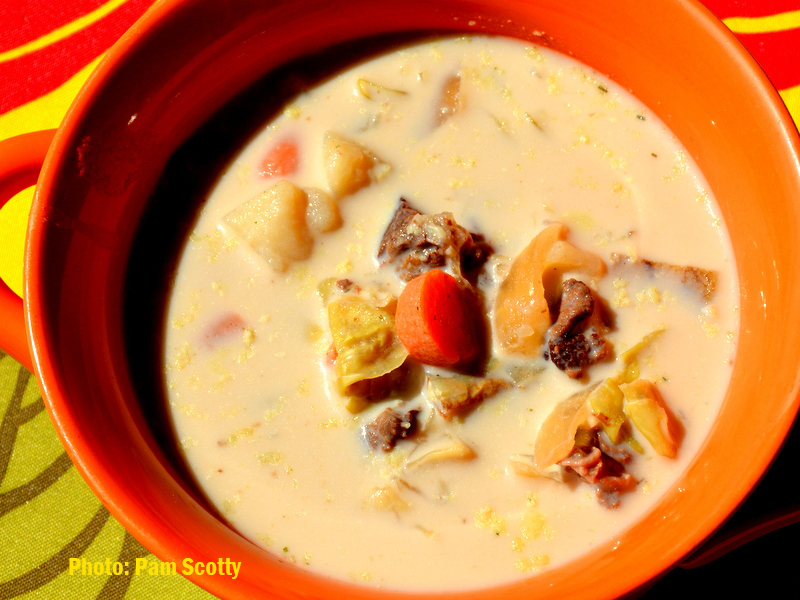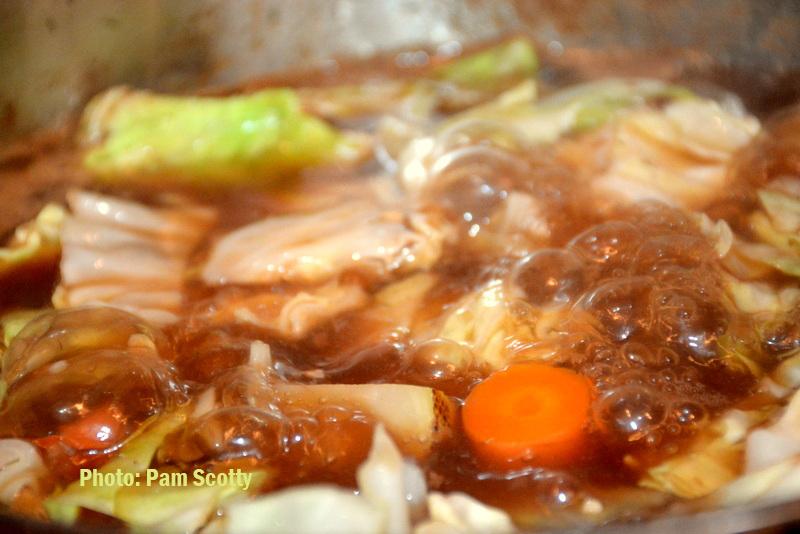Traditional Polish Cabbage Soup, kapusta, contains pig, cabbage, sauerkraut, onion, and caraway seed. Although this might be the case, my grandmother’s CABBAGE SOUP was in no way comparable. In my family’s recipe, beef and rich beef stock also contain vegetables, primarily cabbage, onion, garlic, potatoes, carrots, and green beans or yellow beans, depending on availability. The finishing touch of adding vinegar and cream makes it distinctive.
Bringing Polish Family Farming to the New World of America
Visit my ethnic comfort blogs, Ethnic Polish Halushki, a Global Comfort Food, and Ethnic Polish Golumpki, or Stuffed Cabbage Rolls, to learn more about my Polish ancestry.
My grandfather, Michael, and his wife, Mary, arrived in America from Poland and made Salamanca, New York, their new home on the Allegheny River. They transferred from a modest cottage by the river (where Mom was born) to their newly built brick house on Clinton Street in 1923.
Plenty of space from the concrete break wall shielded the house from major floods. The soil was productive. Michael established substantial family gardens. A large portion produced much of the family’s food and fruit. There were apple, pear, cherry, plum, and cherry trees. Crops like cabbage, rhubarb, carrots, beans, tomatoes, onions, garlic, beets, squash, and several green types were in great supply.
They grew potatoes on another property they owned that was uphill on Fairmount Avenue and close to the hospital. My mind transports me to the cold cellar in a built-in basement facing the river. Apples, potatoes, onions, and squash were all preserved for the winter. The basement also had a pantry with jars of fruit and vegetables.
Creamed Polish Cabbage Soup with Beef
The base is a rich beef stock, typically made with 100% water, 50% roasted bones, and 10% mirepoix. Mirepoix pronounced meer-PWAH, is an aromatic flavor base made by slowly cooking onions, celery, and carrots in butter or oil to bring out their natural flavors without browning or caramelizing them. I changed the way I cook today. Today, I make my stock in the Instant Pot rather than a stockpot. In addition, the stock is chilled and defatted, against family tradition.
Now let’s go right to the point! Even though I prepare stock in the Instant Pot, I only use the traditional method to make my grandmother’s cabbage soup. After trying it in the Instant Pot, it’s not the same! Use your stockpot, is what I would advise.
- Make your beef stock first, then (stockpot or Instant Pot). Defat.
- Roast three pounds of beef chuck at 350 degrees for about one hour. Avoid overcooking it. Cool. Cut into bite-sized pieces.
- If available, clean and cut into bite-sized pieces the following vegetables: cabbage, onion, garlic, potatoes, carrots, green beans, and yellow beans. You get to decide on the quantity!
- In the stockpot, lightly sauté the cabbage, onion, and garlic.
- Add stock, beans, and carrots. Bring it to a boil.
- The potatoes and beef chunks should be added immediately to the stockpot. Heat reduction to roughly 250 degrees (medium-low).
- Simmer until the vegetables are tender. If you’re preparing a large batch, simmer for longer, perhaps for an additional hour.
- Take it out of the stove. Cool. (Place the saucepan in the clogged kitchen sink’s ice bath of water and ice cubes.) Then chill. Defat once again. Overnight refrigeration of the soup is my preference.
- Finish: The final step is to add the vinegar and cream (half-and-half works too).
- Importantly, the soup needs to be cool while adding the vinegar and cream. If it’s too warm, the broth mixture will curdle.
- Begin by adding a little apple cider vinegar.
- Once the soup tastes balanced, stir, taste, and adjust as necessary.
- When adding the cream, pour it slowly and whisk to prevent curdling.
- When reheating the soup for serving, do not let it come to a boil.
Of course, some people can’t wait and demand their bowl of soup immediately. (That’s me!)
Served with rye bread, which I learned from my parents and grandparents, is equally dipped into the soup stock. For ages, chleb (bread) has accompanied Polish cuisine and customs. Use wheat in its place if you don’t have rye.
What can one drink when eating Polish food?
Like their surrounding neighbors, the Poles also drank beer and vodka with their meals (and otherwise). Although many people don’t place wine high on their list of priorities, some people, like my grandfather, enjoy wine with their meals. I grew up drinking because of the American-Polish (European) culture. Unlike my peers, I thought drinking wine or beer for dinner or on special occasions was normal. It wasn’t a matter of feeling popular. On the contrary, it was a party that brought people together and went well with the grape and the food.
We now provide a glass of wine with our family meals as a tradition. The broth and cream in my grandmother’s cabbage soup give it a rich flavor. Additionally, there is a sweet note in our cabbage soup.



